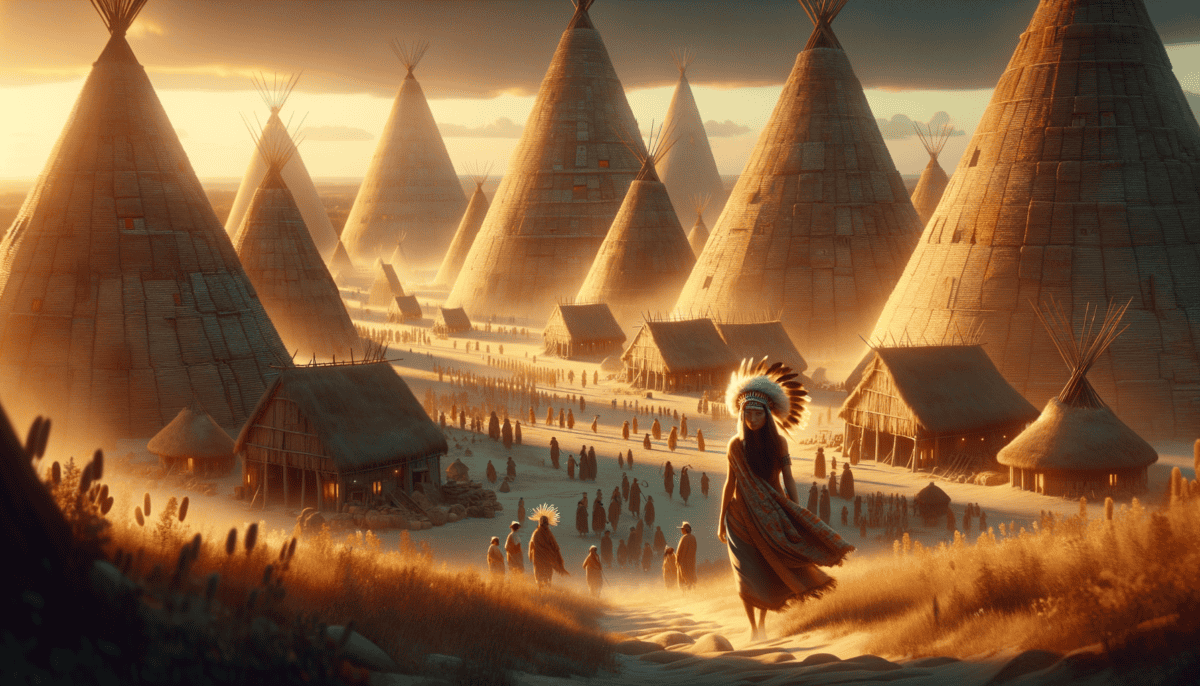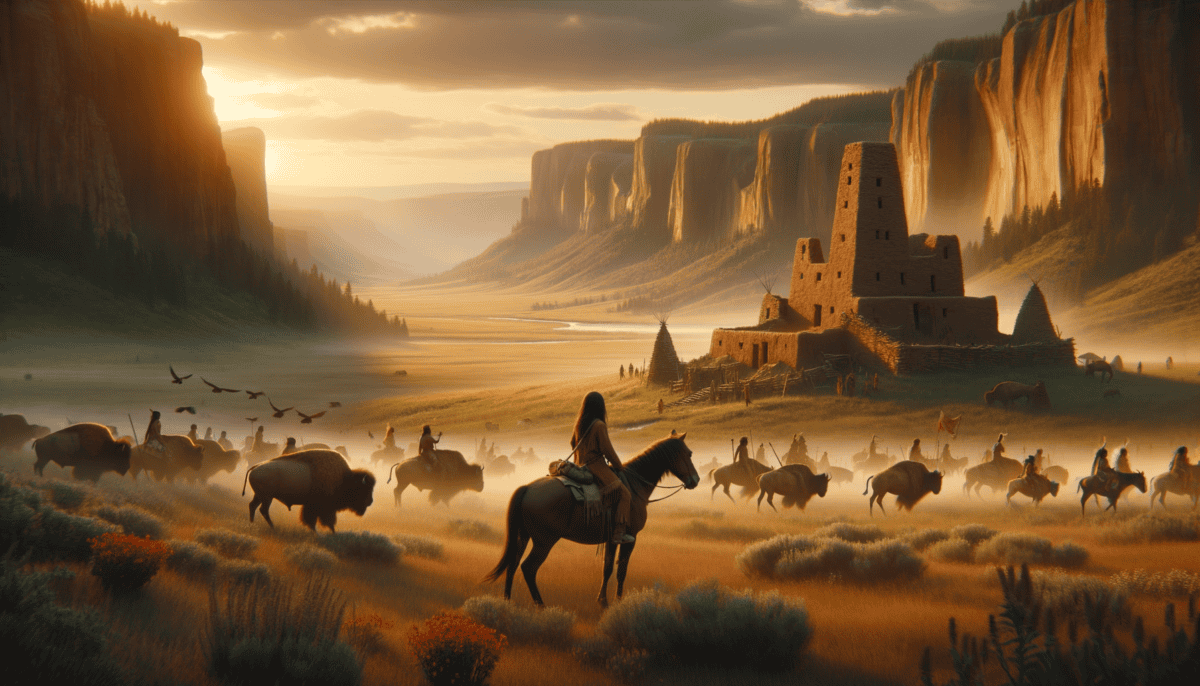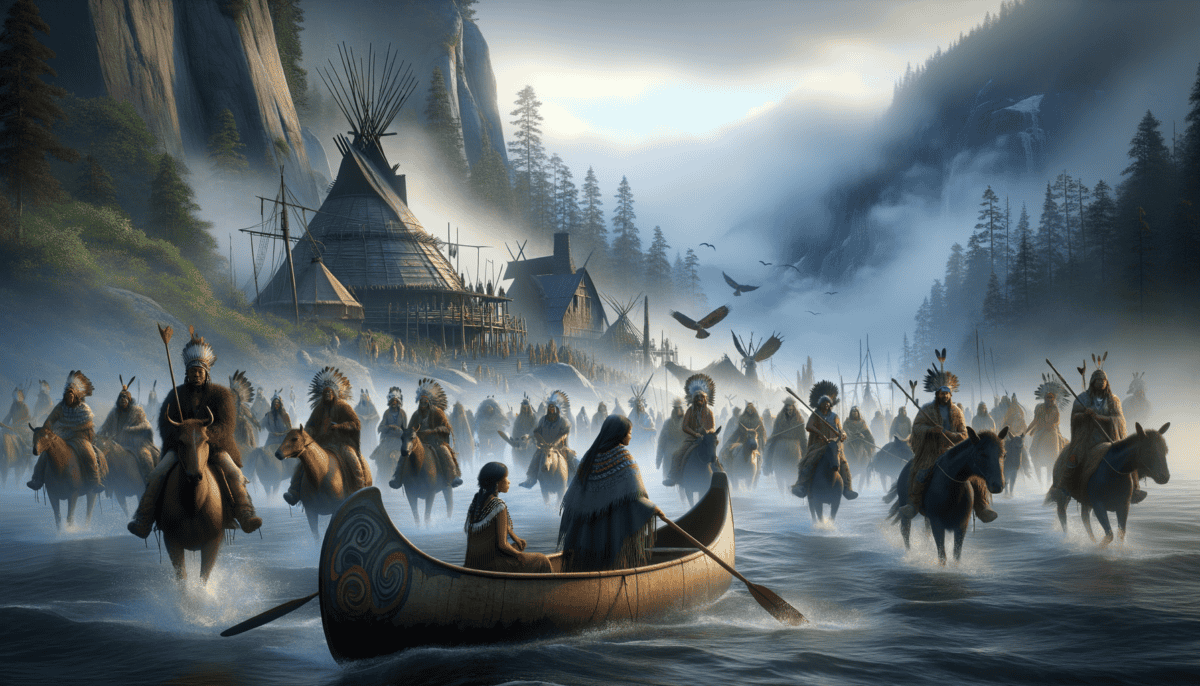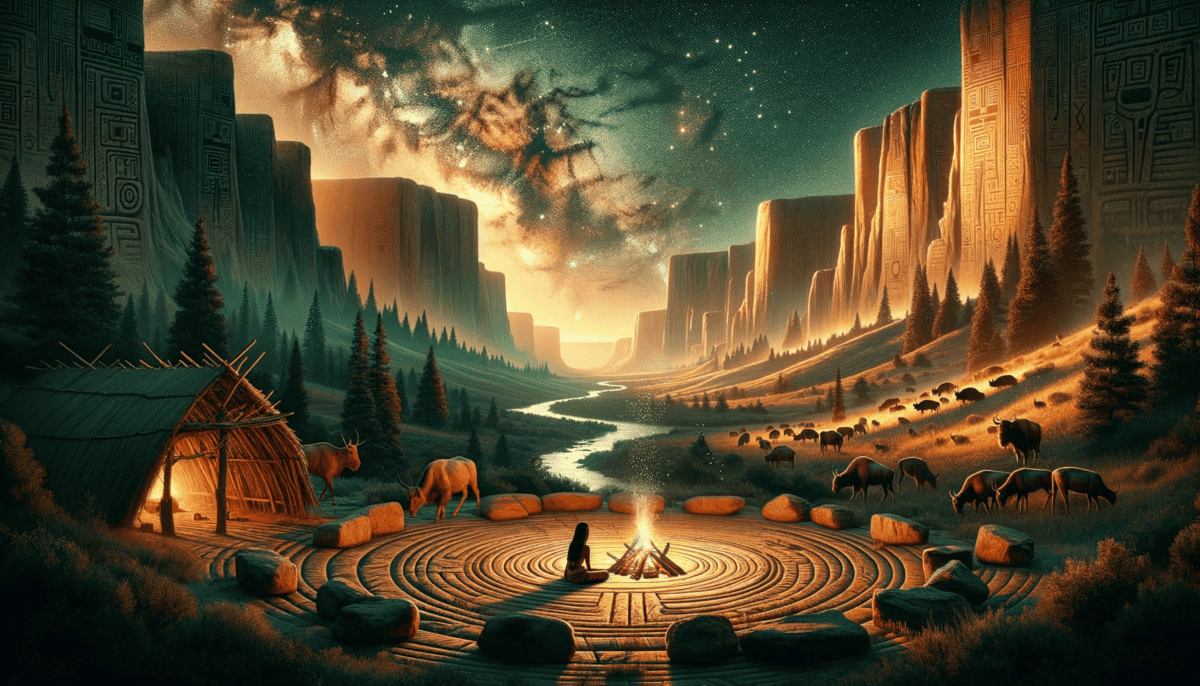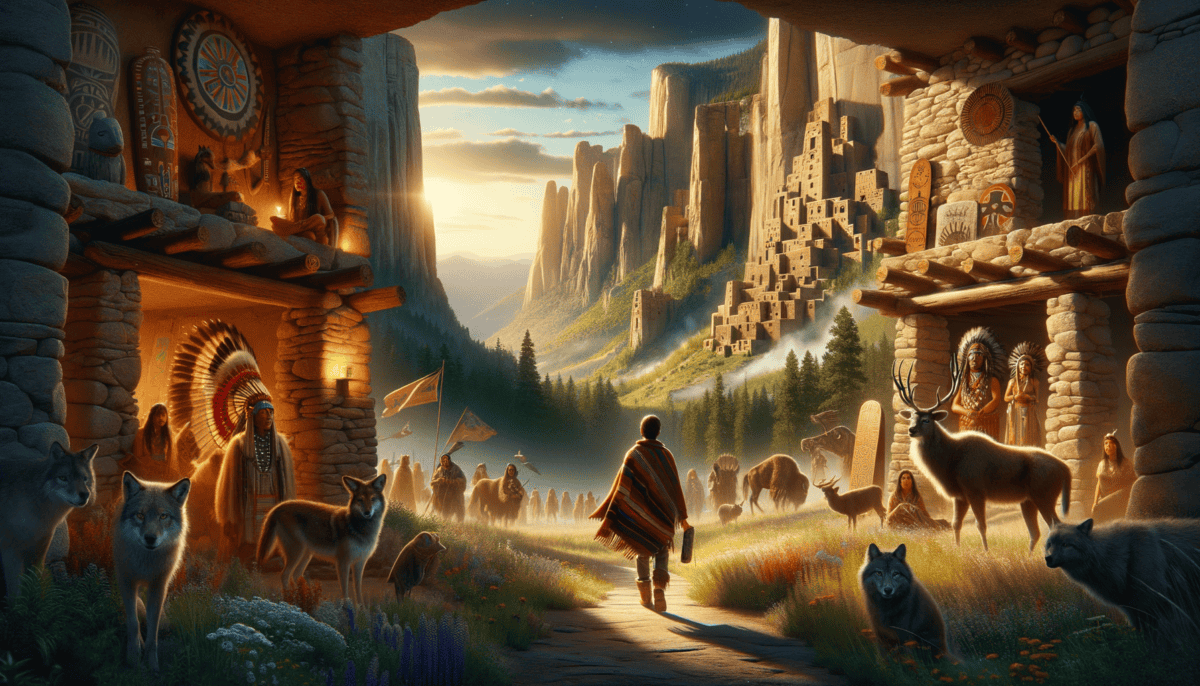The Unexpected Journey
Maya huffed as she kicked a small stone along the dusty trail. Another boring field trip to look at old rocks and buildings. The sun beat down on her baseball cap as she lagged behind her classmates.
"This is so dull," she muttered, pulling out her phone. No signal. Perfect.
A strange laugh echoed nearby. "Dull? Oh my, you couldn't be more wrong!"
Maya spun around. There, perched on a red rock, sat the oddest-looking coyote she'd ever seen. Its fur sparkled with what looked like starlight, and its eyes… were those actually twinkling?
"Did… did you just talk?" Maya stammered.
The coyote grinned. "I am Coyote, the one who walks between worlds. And you, young Maya, need to see some things."
Before Maya could reply, the world began to spin. Colors swirled around her like paint in water. When everything stopped, she gasped.
"Welcome to the home of the Ancestral Puebloans," Coyote said proudly. "About 900 years before your time."
Maya's jaw dropped. A young girl about her age walked past, carrying a clay pot decorated with black and white patterns. The girl smiled and waved.
"But… how?" Maya whispered.
"Magic, of course!" Coyote laughed. "Now, let me show you what your textbooks got wrong about Native American life before Columbus arrived."
They walked toward the village, where Maya saw:
- Skilled architects planning new rooms in the cliff face
- Farmers tending crops on desert terraces
- Artists painting stories on pottery
- Children playing games with painted stones
- Elders teaching young ones about the stars
"This is incredible!" Maya exclaimed, watching a group of builders perfectly fit stone blocks together without any mortar. "I had no idea they could build such amazing things."
"That's just the beginning," Coyote said with a knowing smile. "These people created cities as big as the ones in Europe at the same time. They built roads that stretched for hundreds of miles. They studied the stars and planned their buildings to match the sun's movement."
Maya watched in wonder as daily life unfolded around her. Women ground corn on stone metates while sharing stories. Men returned from hunting trips with rabbits and deer. Children played games that taught them important skills.
"It's like a whole city built into the cliffs," Maya said, touching the cool stone walls. "And look at those windows and doors – they're perfect rectangles!"
Coyote nodded. "These builders were masters of architecture. They understood how to use the sun to keep their homes warm in winter and cool in summer."
As the sun began to set, Maya noticed something special. The last rays of light shone through carefully placed windows, creating patterns on the back walls of rooms.
"That's no accident," Coyote explained. "They built these homes to track the seasons. When the light hits certain spots, they know it's time to plant or harvest."
Maya thought about her earlier boredom and felt shame creep into her cheeks. "I can't believe I thought Native American history was boring. This is amazing!"
"And this is just one small part of the story," Coyote said with a mysterious twinkle in his eye. "Ready to see more?"
The sunset painted the cliff dwellings in brilliant orange and purple as Maya nodded eagerly. She couldn't wait to discover what other wonders awaited her on this magical journey through time.
Mississippian Mysteries
The world swirled again, and Maya found herself standing beside Coyote in a completely different place. Before them rose an enormous earthen mound, shaped like a pyramid with a flat top. ️
“Welcome to Cahokia,” Coyote announced proudly. “The largest city north of Mexico in the year 1200!”
Maya’s eyes widened at the sight of a bustling city larger than London was at the same time. Thousands of people moved through wide plazas and streets laid out in perfect grids.
“But I thought Native Americans only lived in small villages,” Maya said, watching crowds of people trading goods in the marketplace below.
Coyote laughed, his star-speckled fur glinting in the sunlight. “Oh, there’s so much more to learn! Look there!” He pointed with his nose toward the grand staircase leading up the main mound.
A group of leaders descended the stairs, wearing brilliant cloaks decorated with shell beads and copper ornaments. Their headdresses sparkled with pearls and polished stones.
“These are the Mississippian people,” Coyote explained. “Master traders, builders, and astronomers.”
Maya watched in amazement as people worked together to build a new mound:
• Workers carrying baskets of earth
• Engineers marking precise measurements
• Architects directing the construction
• Artists planning temple decorations
• Priests blessing the foundation
A young boy about Maya’s age approached, carrying a tray of freshly made corn cakes. “Would you like one?” he offered with a smile. “I’m Running Deer.”
“These are delicious!” Maya exclaimed after taking a bite. “Did you grow this corn here?”
“Yes!” Running Deer beamed. “We grow corn, beans, and squash together. The beans climb the corn stalks, and the squash leaves keep the ground cool. They help each other grow, just like people help each other.”
Throughout the day, Maya discovered more amazing things. She saw:
Artists crafting delicate shell gorgets with intricate designs
Traders exchanging copper from the Great Lakes for shells from the Gulf Coast
Astronomers marking the movement of the sun with tall wooden poles
Coyote led Maya to a workshop where craftspeople worked with copper. “Watch this,” he said as an artisan heated and shaped the red metal into a beautiful bird design.
“They didn’t have iron tools,” Maya observed. “But look what they can make!”
“These people developed their own technologies,” Coyote nodded. “They built huge cities without metal tools or wheeled vehicles. They created vast trade networks spanning thousands of miles without horses or ships.”
As evening approached, Maya joined a community feast. People shared stories and songs while enjoying a meal of roasted deer, fresh fish, and vegetables from their gardens.
“Everyone works together here,” Running Deer explained. “When we build a mound, plant crops, or hold ceremonies, we all help each other.”
Maya watched as children played a game using chunkey stones – polished discs they rolled across the plaza while throwing spears to predict where the stone would stop.
“This isn’t just a game,” Coyote explained. “It teaches skills for hunting and trains young people to work together.”
The sun began to set, painting the massive mounds in golden light. Drums began to beat as people gathered for an evening ceremony.
“Ready to see another amazing place?” Coyote asked with a mischievous grin.
Maya nodded eagerly, her mind full of images of this incredible city and its sophisticated society. As the world began to spin again, she couldn’t wait to discover what other wonders awaited her on this magical journey through time.
Spirits of the Great Plains
The spinning stopped, and Maya found herself standing in a vast sea of grass stretching to the horizon. The wind carried the sweet scent of prairie flowers, and in the distance, dark shapes moved across the landscape.
“Those are buffalo!” Coyote said, his tail swishing excitedly. “The heartbeat of the Plains people.”
A young girl named Swift Feather approached Maya, her braided hair adorned with colorful beads. “Welcome to our camp! Would you like to help prepare for the buffalo hunt?”
The Plains people didn’t just hunt buffalo – they honored them. Every part of the animal was used with respect and gratitude.
Swift Feather showed Maya the camp’s activities:
• Making arrows with sharp stone points
• Crafting sturdy bows from ash wood
• Preparing medicine bundles for good luck
• Sewing warm clothes from buffalo hide
• Training young horses for the hunt
“Watch how the hunters work with the horses,” Coyote pointed. Maya saw riders moving in perfect harmony with their mounts, no saddles needed.
“But I thought Native Americans didn’t have horses until after Columbus?” Maya whispered.
Swift Feather laughed. “That’s right! Before horses, we were master hunters on foot. Let me show you how we did it!”
The girls joined a group learning traditional hunting skills. Maya tried:
Reading buffalo tracks in the grass
Using hand signals to communicate silently
Moving downwind to stay hidden from prey
“Look!” Swift Feather touched Maya’s arm. A magnificent eagle soared overhead. “Eagle teaches us about courage and wisdom.”
That evening, Maya sat with the tribe’s storyteller near the fire. Her eyes grew wide as she heard tales about:
“How Meadowlark brought songs to the people”
“Why Buffalo gives himself to feed the tribes”
“The story of the first sacred pipe”
“Every animal and plant is our relative,” the elder explained. “We learn from them and care for them.”
Maya helped the women scrape a buffalo hide, amazed at how they would use every part:
Meat for food
Bones for tools
Hide for tipis and clothes
Sinew for sewing thread
Nothing was wasted
Swift Feather taught Maya a traditional game using painted plum stones. They laughed together as they played, sharing stories about their lives.
“In my world,” Maya said, “many people think Plains Indians were simple hunters who just followed buffalo.”
Coyote shook his head. “Look closer. See how they read the stars to know when to move camp? How they use plants for medicine? Their knowledge fills libraries!”
Maya watched women creating beautiful patterns on moccasins with tiny beads. Their fingers moved quickly, telling stories through shapes and colors.
A drum began to beat as the sun set. The community gathered for dancing, their feet moving in rhythm with the heartbeat of Mother Earth.
As stars filled the prairie sky, Maya felt a deep connection to this place and these people. Their way of life wasn’t simple – it was rich with wisdom about living in balance with nature.
The familiar tingling sensation returned, and Coyote’s eyes sparkled. “Time to journey on,” he said softly. Maya caught one last glimpse of Swift Feather waving goodbye as the world began to transform once again.
Navigation and Survival
The misty air cleared, and Maya found herself standing on a rocky beach. Tall cedar trees reached toward the sky, and the salty breeze carried the calls of seabirds.
“Welcome to the Pacific Northwest,” Coyote grinned, shaking water from his fur. “Where the people are masters of the sea.”
A boy named Cedar approached, carrying a beautifully carved paddle. “You’re just in time! We’re preparing for the salmon feast.”
The coastal tribes were expert fishers and sailors who built massive canoes from single cedar logs.
Maya watched in amazement as people worked on a huge canoe. Cedar explained the important parts:
• The wide hull for ocean waves
• Special shapes to cut through water
• Strong seats for many paddlers
• Beautiful carvings for protection
• Storage space for trading goods
“Would you like to learn how to paddle?” Cedar asked, handing Maya a smaller carved oar.
The water sparkled as they practiced smooth strokes. Cedar’s grandmother called from shore, “Come see the smokehouse!”
Inside the cedar building, rows of salmon hung drying. The rich smoky scent made Maya’s mouth water.
“We smoke extra fish to trade with inland tribes,” Cedar’s grandmother explained. “Our trading networks stretch for hundreds of miles.”
Maya helped prepare for the evening’s potlatch ceremony:
Setting out carved bowls
Arranging special blankets
Placing gifts in order
“Look up!” Cedar pointed to an enormous totem pole. “Each carving tells part of our family’s story.”
A master carver worked nearby, his tools moving skillfully over cedar wood. He showed Maya how to read the pole’s symbols:
Eagle at the top for wisdom
Bear showing family strength
Salmon bringing prosperity
That afternoon, Maya joined a group learning to gather shellfish. They used special tools to dig clams, sharing ancient knowledge:
“Watch the tide patterns”
“Know which beaches are safe”
“Leave enough for tomorrow”
Cedar’s father taught navigation secrets:
“See how the waves move? They tell us wind direction. The seabirds show where fish swim. Stars guide us home at night.”
As evening approached, drums began to sound. The potlatch ceremony started with dancers wearing carved masks, telling stories of transformation.
Maya sat beside Cedar’s family, watching as gifts were shared. She learned this wasn’t just giving – it was a complex system of honor and responsibility.
“Your people are incredible sailors,” Maya whispered to Cedar. “I had no idea they traveled so far in these waters.”
Coyote nodded proudly. “They read the ocean like you read books. Every wave has a story.”
The feast continued under star-filled skies. Stories flowed like the tide, speaking of whale hunts, great journeys, and ancient wisdom.
Maya felt the familiar tingle begin. She hugged Cedar goodbye, carrying new understanding of these skilled maritime people as the world began to shift once more.
Crossroads of Understanding
Maya sat beside Coyote on a high cliff, watching the sunset paint the sky in brilliant oranges and purples. The trickster spirit’s tail swished thoughtfully as they looked out over the vast landscape.
“What are you thinking about, young one?” Coyote asked, noticing Maya’s contemplative expression.
Maya hugged her knees to her chest. “I was wrong about so many things. The history books at school… they don’t tell the whole story.”
“Sometimes the greatest wisdom comes from admitting what we didn’t know,” Coyote replied with a gentle smile.
Images from her journey danced through Maya’s mind:
The incredible achievements she had witnessed:
• The Puebloan cliff cities touching the sky
• Mississippian trade networks spanning thousands of miles
• Plains tribes’ deep connection with the buffalo
• Pacific Northwest sailors mastering the ocean waves
“I used to think…” Maya’s voice caught with emotion. “I used to think all Native Americans lived the same way. But every place, every people – they were so different, so special.”
Coyote’s eyes twinkled. “Tell me what you’ve learned, child.”
Maya remembered the Puebloan grandmother teaching her to grind corn, patient hands guiding her movements. The complex irrigation systems that brought life to desert gardens.
“They were master builders and farmers,” she said. “They created cities in the cliffs and knew how to survive in the desert.”
The memory of Mississippian markets filled her thoughts – the buzz of traders, the sparkle of shells and copper, the impressive mounds rising above the plains.
“And the Mississippian people!” Maya exclaimed. “Their cities were huge! They built those amazing mounds and traded across the whole continent.”
Coyote nodded encouragingly. “What about the Plains?”
Maya closed her eyes, feeling again the thunder of buffalo hooves, the wind in her hair as she rode with the hunters. “They weren’t just hunters – they were scientists who understood the grass, the weather, the animals. Everything was connected.”
“And the coastal tribes?” Coyote prompted.
“Amazing sailors and artists! Their canoes could cross oceans, and their totem poles told stories that lasted generations. Plus, they created whole systems of sharing wealth through potlatch ceremonies.”
“You see now how rich and diverse these cultures were,” Coyote said. “Each adapted perfectly to their home, each developing their own special wisdom.”
Maya stood up, facing the setting sun. “I wish everyone could see what I’ve seen. These weren’t simple people – they were engineers, astronomers, artists, and philosophers.”
A cool breeze carried the scent of sage. Maya noticed something changing in the air around them – that familiar shimmer that meant another journey was coming.
“Coyote,” she said quickly, “why did you choose me for this journey?”
The trickster spirit’s eyes held ancient wisdom. “Because you were ready to learn. Ready to see with new eyes. Ready to carry these truths forward.”
As the world began to shift and swirl around them, Maya clutched a small pouch of treasures from her journey – a pottery shard, a trade bead, a buffalo tooth, a carved cedar chip. Each one held memories of the incredible cultures she had witnessed.
The wind began to sing with voices from all her adventures, weaving together in a powerful harmony. Maya understood now that these weren’t just stories from the past – they were living wisdom that could light the way forward.
Return and Revelation
The world stopped spinning, and Maya found herself standing in her school’s Native American history exhibit. Sunlight streamed through the windows, making the display cases sparkle.
Coyote sat beside her, his form slightly transparent in the modern lighting. “Our journey is nearly complete, little one.”
Maya approached a glass case containing arrowheads and pottery pieces. Her eyes filled with tears as memories rushed back.
“These aren’t just objects,” she whispered. “They’re stories. They’re people. They’re whole worlds.”
A group of students walked past, barely glancing at the exhibits. Maya’s heart ached, remembering how she used to do the same.
Maya touched her pouch of treasures, thinking of all she had learned:
The wisdom of sustainable living
The power of community
The beauty of diverse traditions
The importance of balance with nature
The strength of indigenous knowledge
Her teacher, Ms. Thompson, approached with a curious smile. “Maya? I didn’t expect to see you here during lunch break.”
Maya straightened up, feeling Coyote’s encouraging presence. “Ms. Thompson, would it be okay if I gave a presentation to the class about Native American cultures?”
The teacher’s eyes lit up with interest. “What inspired this idea?”
“I’ve learned so much about how advanced and different each nation was. Like the Puebloan people – did you know they built entire cities in cliffs and had amazing water systems?”
Maya’s voice grew stronger as she continued. “And the Mississippian traders created huge networks across America. The Plains peoples knew exactly how to keep the buffalo herds healthy. The Pacific Northwest tribes could navigate better than anyone in the world!”
Ms. Thompson smiled warmly. “You seem very passionate about this. I’d love to have you share with the class.”
As her teacher walked away, Coyote’s voice rumbled softly. “You see? The journey doesn’t end here – it’s just beginning.”
Maya touched the smooth pottery shard in her pouch. “Will I ever see those places again, Coyote?”
“They live on in you now,” he replied. “In your heart, your words, your understanding. That’s how wisdom survives – through those who learn and share it.”
“The past isn’t dead, young one. It dances in the present, waiting to be seen by those with open eyes.”
Maya watched as Coyote’s form began to fade. “Wait! Will I see you again?”
His laugh echoed gently. “I am in every story that makes you question what you think you know. In every moment that opens your mind to new truths.”
As Coyote disappeared completely, Maya stood taller, filled with purpose. She would help others see what she had seen – the brilliance, the complexity, the wonder of America’s first peoples.
The bell rang, signaling the end of lunch. Maya smiled, ready to begin her new role as a keeper of stories, a bridge between worlds, a voice for the wisdom she had discovered.
In her pocket, the small treasures seemed to pulse with warmth, reminding her that some journeys never really end – they just change shape and continue on through new storytellers, new understandings, and new dreams. ✨


